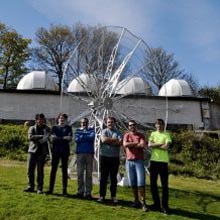Outreach: Schools and community engagement
The Astrophysics group support schools and public events.
In recent years, we have:
- given talks in Devon and Cornwall schools for the Institute of Physics,
- participated in Big Bang! SW
- supported BBC Stargazing Live! astronomy evenings for schools and Exmoor National Park.
We also regularly provide speakers to amateur astronomy groups and Café Scientifique.
Activities we can typically offer include:
- Astrophysics talks on star formation and extrasolar planets
- A 'From Earth to the Universe' exhibition of 30 large-format images of space
- Telescopes and binoculars
- Scale models of the Solar System and extrasolar planets
- Crater making
- Meteorites
Learning resources
Our learning resources include videos, webpages and games aimed at GCSE and A-level students, covering:
- Star formation
- Exoplanets
- Stellar physics
- Gravity and drag
- Intrasolar bodies
- Astrophysical processes
Learning resources page »
Contact us
If you are interested in working with us or learning more about our outreach events please email us.
The Exeter Radio Telescope at Caradon (XRT-C) Project

The award-winning Exeter Radio Telescope at Caradon (XRT-C) project is an official national project of UK Students for the Exploration and Development of Space (UKSEDS), based and run primarily by students at the University of Exeter. We are building a 4.5m radio telescope for use as an education and research tool for students across the country. This is a student led project from the very beginning with students working together to plan, procure, construct and operate the final project.
The telescope is situated at Caradon Observatory near Bodmin moor in Cornwall, which boasts some of the finest dark skies the UK has to offer. Although light pollution doesn’t affect radio observations, it does mean that our optical counterparts at the observatory have excellent observing on a regular basis, offering superb opportunities for on-site collaborations. In addition, the observatory is nestled on the side of the Lynher valley, which offers shelter from many nearby sources of radio noise.
Project aims
Our first major project is to conduct a neutral hydrogen survey of the galactic plane, observing the ubiquitous 21cm emission line resulting from the hyperfine splitting of ground state hydrogen. As well as serving as reference material for others, the data captured during this survey will allow us to calculate the mass of our galaxy, the Milky Way.
When the telescope is fully commissioned we hope to be working with students and astronomers across the UK to conduct observations of other 21cm sources. We also want to use the telescope and the data it produces as an outreach tool to engage people in the exciting fields of astronomy and astrophysics.
Future prospects
There are many future directions we could move in with the project. One potential direction is to attempt to establish a Very Long Baseline Interferometry (VLBI) array with collaborators here at Exeter. This has the potential to drastically increase the resolution of both telescopes by precisely correlating the signals they receive, effectively forming an aperture as wide as the distance between them. With this we’d have the potential of resolving much finer details in the sky.
To find out more about radio astronomy, the telescope and keep up to date with the project visit our website. We can also be found on Twitter and Facebook, where we regularly post about the progress of the project.

